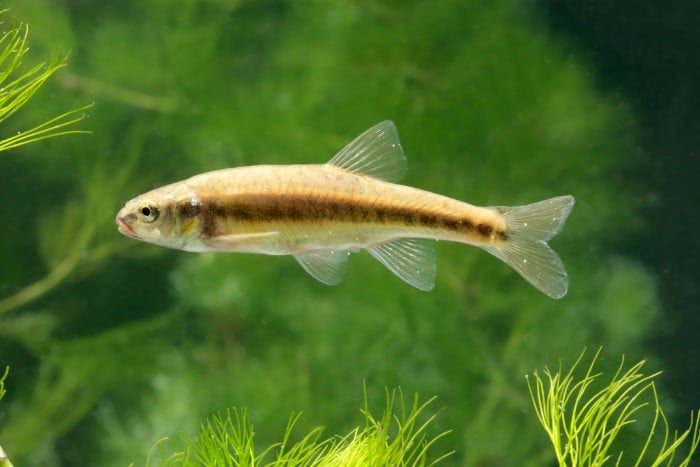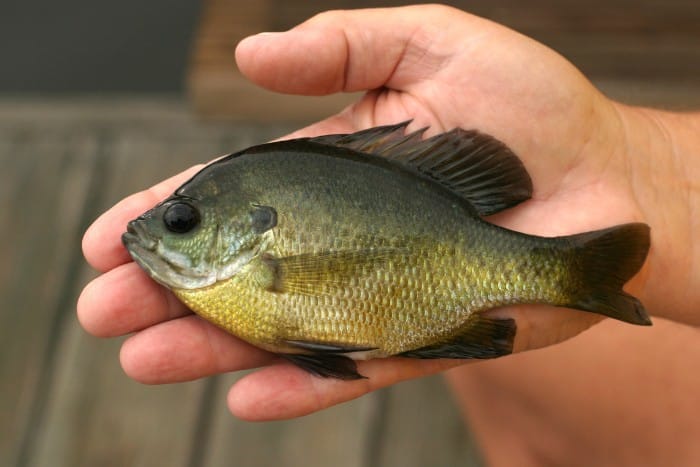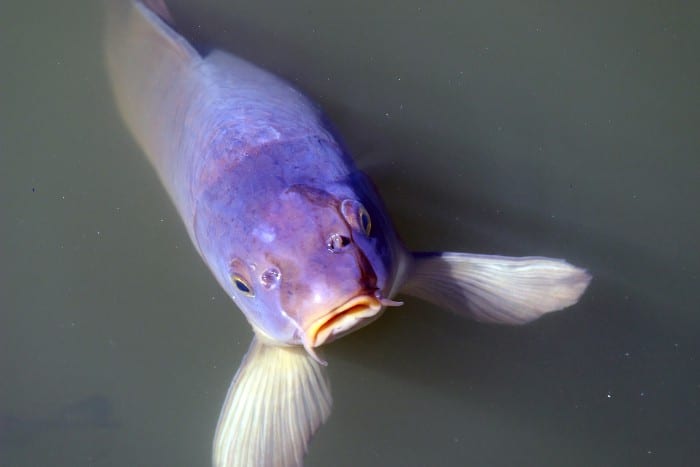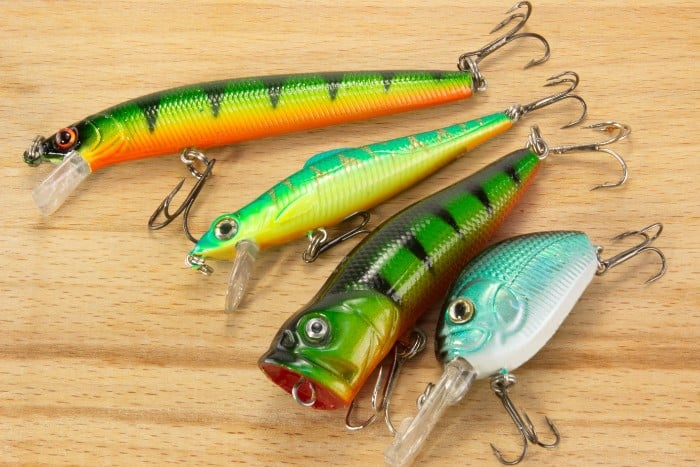Few fish are as aggressive and fun to land through the ice as pike. Whether you’re targeting them on a tip-up or with a rod and reel, you’ll find that they hit and fight, unlike almost all freshwater fish. You’ll give yourself a chance to catch a trophy if you know the proper bait and location.
Arguably the best bait for pike are live minnows. Suckers, smelt, shad, and shiners are all very successful. Pike will also eat dead minnows and smaller panfish when given the chance. Pike are known to strike spinners, plugs, swimbaits, as well as spoons. If it’s living or has action, it’ll work.
While landing pike through the ice isn’t a guarantee, the use of proper baits is a great place to start.
Live Bait
Anglers who can target pike through the ice almost always like to start fishing with live bait. Live bait like minnows will swim around near the bottom of the water column and attract any predators in the area.
While they generally don’t last long when being fished through the ice, a minnow in distress is as enticing as it gets for a pike.
Make sure you drop the minnows near areas of structure. Pike sit near these areas because they know smaller fish also spend time near structure.
They’ll hide in weeds or other areas of cover and wait for a fish to venture too far out into the open, and then they’ll strike. When they see the hooked minnows, it’s game over.
1. Sucker Minnows
Sucker minnows are some of the most resilient minnows you can find. They can grow to double-digit inches in length, but the best size is somewhere around 5 inches.
Whenever you put them on your hook or attach them to a tip-up, they’ll be able to swim around for nearly the entire day.
As a result, you don’t have to spend time changing out minnows every few minutes to ensure they stay lively.
Sucker minnows have a white belly, so pike can easily see them if they hunt them from the bottom. The top of their bodies are a darker brown color, so they blend in well. Their activity, however, makes up for it.
When you hook the sucker minnow, make sure you don’t bury the hook too far into them. Most anglers prefer to hook sucker minnows right behind the dorsal fin.
Barely break the skin! If you bury the hook too far into their back, you’ll ruin their spine and cause them to be paralyzed in the water.
Some will hook them through the mouths, but this doesn’t allow them to swim as well as if they’re hooked through the dorsal.

2. Smelt
Smelt are far more delicate than sucker minnows. When hooked, smelt will only be active for a few hours, and then they’ll die.
If you want to give them the best chance of survival, fish them in moving water. They thrive when the water is highly oxygenated, so finding a river that’s frozen over and smelt would be a good option.
Smelt are common choices for anglers when they want to use dead bait. They release quite a few oils when they die, attracting fish from all over.
You can find smelt on both coasts and various rivers and lakes across North America. Smelt aren’t as large as sucker minnows, and they’re most productive to use when they’re 3 inches or 4 inches.
Similar to the sucker minnows, you’ll want to hook smelt right behind the dorsal fin, which allows them to swim freely and be active for a few hours before they become dead bait.
3. Shad
Shad will produce quite a few pike if you’re fishing in the shallows. Many anglers choose shad when the pike are in the pre-spawn in late February and March.
Pike begin moving up into the shallows as the ice melts and the temperatures start to rise. Since shad swim in schools in the shallows, it’s not uncommon for them to see a stray shad near shallow water.
Be ready to set the hook when that pike takes your shad. They’re eager to feed on more, so they’ll take it and run when they get the chance.
The best option is a four- or five-inch shad hooked behind the dorsal fin. They’re on a similar level with sucker minnows in their resilience.
They can stay alive for at least half of the day if they aren’t too deeply hooked.
4. Shiners
Shiner minnows in the 4-6 inch range are some of the best pike bait on the market. Like suckers, shiner minnows are able to grow much larger than 6 inches, but they don’t always produce as much fish.
If you’re married to landing a trophy pike, feel free to fish with an 8 to 10-inch shiner. However, you will likely find that you don’t catch as many as you would with a 6-8 inch shiner, but it all depends on the day.
Fish them with a few split shots and a hook, and you’ll be good to go. You want shiner minnows to swim as freely as possible, so the less weight you can attach to them, the better.
If you purchase them and they’re healthy, they will swim throughout the entire day. Make sure you pay close attention to how lively they appear when you do buy them.
5. Panfish
If you’re interested in catching your own bait, you can have a ton of success landing pike.
Panfish like bluegill, perch, and crappie are prevalent in waters where pike live, so if you are able to catch them, you can more than likely use them as bait.
You’ll have to check your local rules and regulations, but most areas allow this for fishing.
A small, four or 5-inch bluegill or perch is just about right. Hook the fish near the dorsal fin and let it swim near structure.
Perch and bluegill are pretty hearty, so they won’t have trouble lasting throughout the morning or afternoon.

Dead Bait
Dead bait is another standard option for anglers. Dead bait is easy to use if you choose to dead stick or fish with tip-ups.
You aren’t required to have the rod in your hand when you’re dead sticking, and you can wait for the fish to take the bait.
Drop your bait all the way to the bottom and leave it. The oils from the dead bait will attract any pike looking for an easy meal.
1. Sucker Chunks or Minnows
Most bodies of water that hold pike also have populations of suckers. Many sucker populations are filled with 10-20 inch fish.
While pike will eat the 10-15 inch suckers, it isn’t a regular occurrence. So, one thing many anglers do is to cut the sucker into different chunks.
If you cut a sucker into chunks, quickly attach it to your hook and drop it, you’ll see that the oils from the meat fill the surrounding water.
Oils are precisely what pike want to smell and see.
That freshly cut meat is hard for them to avoid, so if you do land a sucker that is too large to use as live bait, cut it into a few pieces, attach it to a hook, and drop it towards the bottom.
Similar to the cut meat, dead five or 6-inch sucker minnows are easy targets for pike. Lay them on the bottom, and you have a good chance of catching a cruising pike.
Other anglers will use fully intact dead sucker minnows.

2. Sardines
Yes, sardines are a saltwater fish, but they are more potent than most baits you can find. Secure a sardine on your hook and use it on a tip-up or a dead stick.
As soon as it hits the water, pike are going to know it’s there. The scent is too powerful and unfamiliar for pike to avoid.
It likely won’t take long for them to notice and want a chance at eating it. Sardines are an especially useful bait if you know the water you’re fishing in is dirty.
Pike will follow the scent trail until they get to your bait.
Make sure you handle sardines with care. You don’t want to hold them for too long, or your ice shanty will not smell good.
3. Herring
Herring are some of the more oily fish you can use for pike. Plus, they are nearly as smelly as sardines. The combination of the oil and the smell make for a perfect pike bait.
Even though herring aren’t native to pike waters, they still do the trick.
Make sure they’re hooked through the toughest section of their body because they can become soft the longer they sit in the water.
You want to make sure they don’t break apart and leave your hook as they’re sitting on the bottom.
Lures
During the open water pike season, lures are a blast to use. You can cover quite a bit of water, and the movement of the lures is exactly what pike wants.
However, ice fishing doesn’t allow you to get as much action out of your lures, but they can still do the trick. Lures can be a good choice if you aren’t a huge fan of live-bait fishing.
Many anglers would still recommend tipping your lure’s hooks with a minnow head or a small piece of meat to make the presentation even better.
1. Rattling Baits
While Jigging Rapalas are favorite baits in the bass fishing community, they tend to do some serious damage when fishing for pike through the ice.
These lures look like small minnows and baitfish, and the rattle adds a little bit more to the entire presentation. When fishing for pike, make sure the Rapala you use is around 3 or 4 inches long.
While 3 and 4 inches are on the larger end of Rapalas, they are nearly the perfect size to get pike interested. Let rattling baits fall to the bottom on their own.
After they hit bottom, jig them a few feet at a time. You want to make sure they are able to create the rattles and movements, so large retrieves and falls will better help you accomplish this.

2. Swimming Lure
Any sort of swimming lure is another good option when you’re ice fishing for pike. Swim baits are able to move side to side even if you’re jigging them up and down.
Most lures anglers use in the winter are only able to accomplish a vertical motion, so a side-to-side action is hard to beat.
You’ll tie your leader to the middle of the bait instead of one end, allowing the bait to get that side-to-side movement.
Swimming lures create enough action that you don’t necessarily need to tip them with any meat, but it never hurts to add a little something extra to help attract those pike.
Make sure you do long drops and retrieves with swimming lures. You’ll want them to move quite a bit. The longer the jigging motion, the better.
3. Spoons
Spoons are far and away the most popular type of lure for pike fishing through the ice. When jigged, spoons will flutter back and forth and reflect any light that is able to make its way through the hole.
The flashes, reflections, and flutters are what entice a fish to take a long look at the spoon before they strike it.
Some anglers will decide to tip their spoons with a tiny bit of meat or a minnow head just to add that little incentive for the pike to strike. Even a small bit of meat can go a long way in enticing pike.
Size & Color of Lures
Due to the nearly infinite number of sizes and colors available on the market for lures, it can be challenging to know which option is best.
While pike are generally attracted to large baits due to the potential full meal, it doesn’t mean they’ll want large baits in the dead of winter.
Even pike slow down in the winter, so make sure you don’t use a traditional warm-weather pike lure.
A lure that’s 3 inches to 5 inches long that’s somewhere between .75 and 1.5 ounces, is about right. It’s heavy enough to fall to the bottom and not large enough to scare the pike away.
In terms of colors, one solid color like gray, white, brown, or black paired with some more flashy colors like bright blue, hot pink and chartreuse are a great combination.
Make sure your lures are paired with the proper leader and line. Pike have sharp teeth, so many anglers use a wire leader so they don’t bite directly through the line.
Conclusion
Ice fishing for pike can feel entirely different from fishing for them in open water. It’s a traditionally active style of fishing with an emphasis on covering water.
In the winter, however, finding the proper location and proper bait is what you should prioritize. Focus on live baits like minnows and panfish setup below tip-ups.
When you’re rod and reel fishing, use lures to try and land pike. Jigging spoons, blade baits, rattling lures, and swimming lures will provide great opportunities to land a trophy through the ice.
Be ready because it’ll be a memorable fight as soon as a pike strikes!
